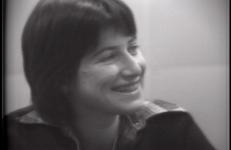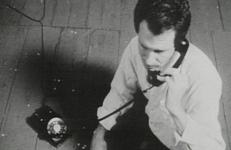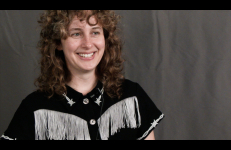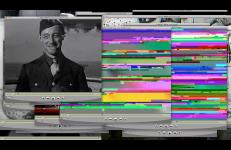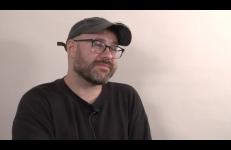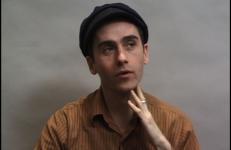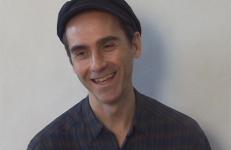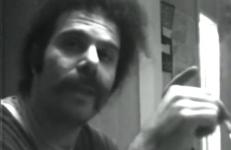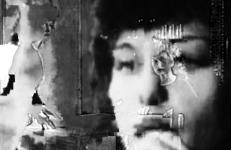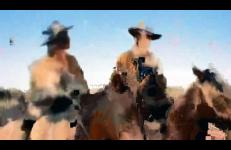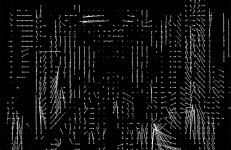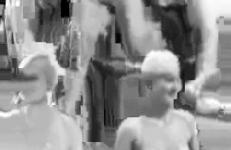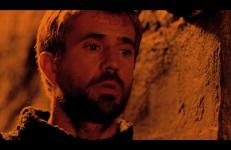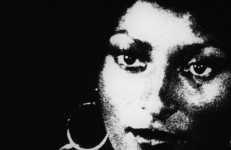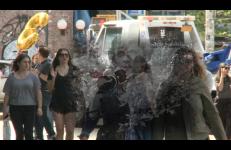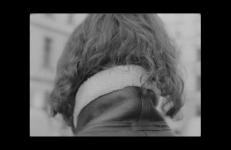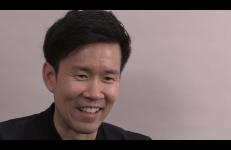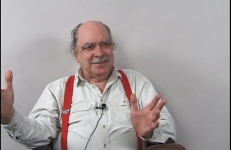Chantal Akerman (1950-2015) gained international recognition with her three-and-a-half hour masterpiece, Jeanne Dielman, 23 Quai du Commerce, 1080 Bruxelles (1975), which portrays a housewife’s dull existence and eventual violent action. She has continued to be one of Europe’s most innovative filmmakers with more than forty film and television projects to her credit. Akerman’s work is minimalist, structuralist, and feminist. Major themes in her films include women at work and at home; women’s relationships to men, other women, and children; food, love, sex, romance, art, and storytelling. In this interview from 1976 Akerman discusses her early films, and the development of her particular vision.
Film Theory
The whole story takes place in the mise-en-scene of the artist's studio. The delicate psychological allegory of "a day in the life of..." anchors the displacement of (filmic) reality and the alienation of the (player's) self. Devices such as incongruity between the image and the soundtrack, odd camera angles, and plays on objective focus, are integral and explicit components of the narrative. Altered to Suit diverges from preceding films in that the dialogue is not solely related to the work; rather the work serves as a central frame of reference from which the story unfolds.
Jessica Bardsley is an artist-scholar working across film, writing, and studio art. Her interdisciplinary research takes an ecological approach to film and media within the global context of contemporary art. In addition to her work as a scholar, she is also an ecofeminist filmmaker.
Big_Sleep™ explores problems in our archival urges. Via a single-channel desktop screencast, informatic elements ebb and flow—creating and relating interface absences. These gaps suggest that no amount of hard drive space can defy mortality.
Big_Sleep™ explores problems in our archival urges. Via a single-channel desktop screencast, informatic elements ebb and flow—creating and relating interface absences. These gaps suggest that no amount of hard drive space can defy mortality.
Zach Blas is an artist, writer, and filmmaker whose practice spans technical investigation, research, conceptualism, performance, and science fiction. Currently a Lecturer in the Department of Visual Cultures at Goldsmiths, University of London, Blas has exhibited internationally, including at the Walker Art Center, Gwangju Biennale, Los Angeles County Museum of Art, and Whitechapel Gallery.
In this 2001 interview, filmmaker Jem Cohen discusses the origins of his film philosophy, and the circuitous route he has taken in his pursuit of an anti-narrative film practice outside the mainstream. Cohen sheds light on the many influences that have impacted his sentiments towards conventional film, and his desire to eschew both classical avant-garde and theatrical filmmaking in favor of a model rooted in the tradition of the 1940s New York School of street photography. Cohen also locates his aesthetic as being impacted by the 1970s hardcore and DIY scenes he was exposed to as a youth in Washington, DC.
In this 2006 interview, filmmaker Jem Cohen discusses his early interest in art, his family’s welcome antipathy towards commercialization, and his unconventional, anti-mainstream film practice. In particular, Cohen discusses his film This is a History of New York, and how this piece exemplifies his interest in the “territory of sensation” rather than simple visual descriptiveness. Cohen concludes by discussing the role of archiving in his practice, and how compulsive documentation of the quotidian and unexceptional can result in the empowerment of the everyday.
Timely concerns about the future of video, artists’ complicity in the money making system of the ‘establishment,’ and the effect of the camera’s presence on personal encounters, is discussed and debated in this late night video produced by David Cort, Chuck Kennedy, and Skip Blumberg.
Lossless #2 is a mesmerizing assemblage of compressed digital images of Maya Deren and Alexander Hammid’s 1943 masterpiece Meshes of the Afternoon. Baron and Goodwin play heavily with Teiji Ito’s 1959 soundtrack, making the film’s lyrical ambience feel more astonishing than ever before. --Neil Karassik
Lossless #2 is a mesmerizing assemblage of compressed digital images of Maya Deren and Alexander Hammid’s 1943 masterpiece Meshes of the Afternoon. Baron and Goodwin play heavily with Teiji Ito’s 1959 soundtrack, making the film’s lyrical ambience feel more astonishing than ever before. --Neil Karassik
Removing keyframes from a digital version of John Ford's The Searchers, Baron and Goodwin attack the film's temporal structuring to render a kinetic “painted desert” of the West. The dust kicked up by the movement in the film is pure pixel, unanchored from the photographic realism that used to constrain it.
Removing keyframes from a digital version of John Ford's The Searchers, Baron and Goodwin attack the film's temporal structuring to render a kinetic “painted desert” of the West. The dust kicked up by the movement in the film is pure pixel, unanchored from the photographic realism that used to constrain it.
Derived from Ernie Gehr's Serene Velocity, Lossless #4 is the result of a digital file's debugging routine that reveals vectors describing apparent movement in the frame. Having removed the picture, thereby isolating these vectors, the formal qualities of Gehr's film are detectable. The hypnotic effects of the shifts in the lens’s focal length in the original are now substituted with a purely graphical representation, creating a perverse replacement of the optical effect of the original.
Derived from Ernie Gehr's Serene Velocity, Lossless #4 is the result of a digital file's debugging routine that reveals vectors describing apparent movement in the frame. Having removed the picture, thereby isolating these vectors, the formal qualities of Gehr's film are detectable. The hypnotic effects of the shifts in the lens’s focal length in the original are now substituted with a purely graphical representation, creating a perverse replacement of the optical effect of the original.
In Lossless #5, a water-ballet crafted by the famed Busby Berkley is compressed into an organic mitosis, within which we detect the spirit of a "buggy" Brakhage ghosting about the integrated circuit.
In Lossless #5, a water-ballet crafted by the famed Busby Berkley is compressed into an organic mitosis, within which we detect the spirit of a "buggy" Brakhage ghosting about the integrated circuit.
Nine Hamlet RGB engages a simple algorithm to destabilize the timing of the red, green and blue frame sequential display system while incorporating fragmented, appropriated “to be or not to be” excerpts from nine Hamlet films. The audio is the synced sound from the appropriated excerpts laced with low frequency binaural tonal pulsations. The physicality of the constructed optical and aural experience is seeking a mechanism of unconscious disarticulation.
Taking its name from the Jim Crow-era of black criminals staring at white women, this hand-processed, optically-printed amalgam reframes desire by way of everything from D.W. Griffith to Foxy Brown and Angela Davis: 'Your lover belongs to this band of murderous outlaws.'
–– Cinematexas International Short Film Festival
This version of the film is a 2K restoration made by the Academy Film Archive in 2022.
Waves crash on rocks as tongues flap in the wind about all things cinematic. People chirp and chew in various states of dress and undress as the climate shifts from coast to coast on the tide of a national pleasure/treasure: film festivals, lectures and art happenings.
The Nothing That Is stems from the environment of our streets, both the “virtual” and “other reality” which inhabits them.
In 1959, Jean Seberg stares into Raoul Coutard’s 35mm camera lens and then turns – the closing frame of Godard’s Breathless is the back of her head. For the film it is a closing. For her character it is less clear. Is it a refusal? A denial? A shying away from? An admission of guilt or not caring? A disappearing act? In 2017 on the streets of Berlin, twenty-three women, friends and passersby, reverse Seberg’s action.
Ming Wong creates videos that explore performance and issues of race and gender. Born in Singapore of Chinese heritage, and now based in Berlin, his work examines cross-cultural experiences by appropriating scenes of iconic world cinema. Wong casts himself anachronistically as the star, critically exposing the otherness of the relationship of media and world history.
In this interview, communications theorist, Gene Youngblood (b. 1942) maps out the various stages of the development of video technology and its philosophical implications for human interaction. The range of topics discussed moves beyond video to offer an extensive and rich survey of American culture from the 1960s to the present moment. In addition to discussing his canonical text, Expanded Cinema, Youngblood shares stories from his early days as a police reporter for the Los Angeles Herald Examiner, where he gained intimate knowledge of the media’s politics of representation. With the acuity of hindsight, Youngblood discusses important self-discoveries, and his life-changing decision to move from the mainstream media into the world of the underground press.




